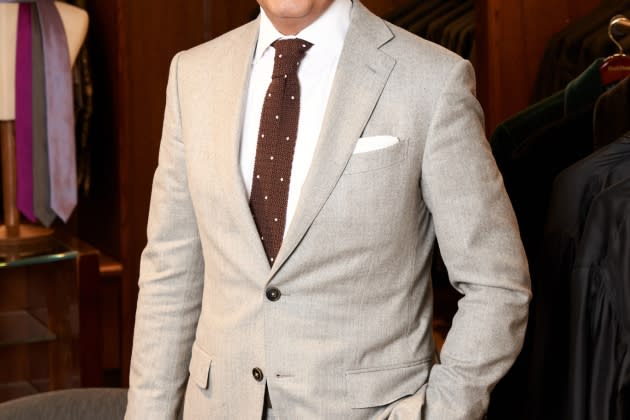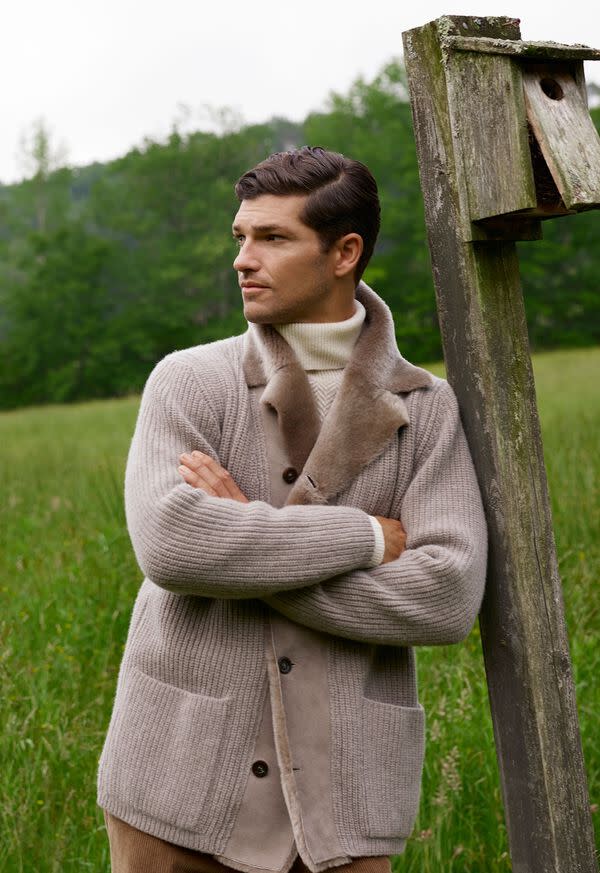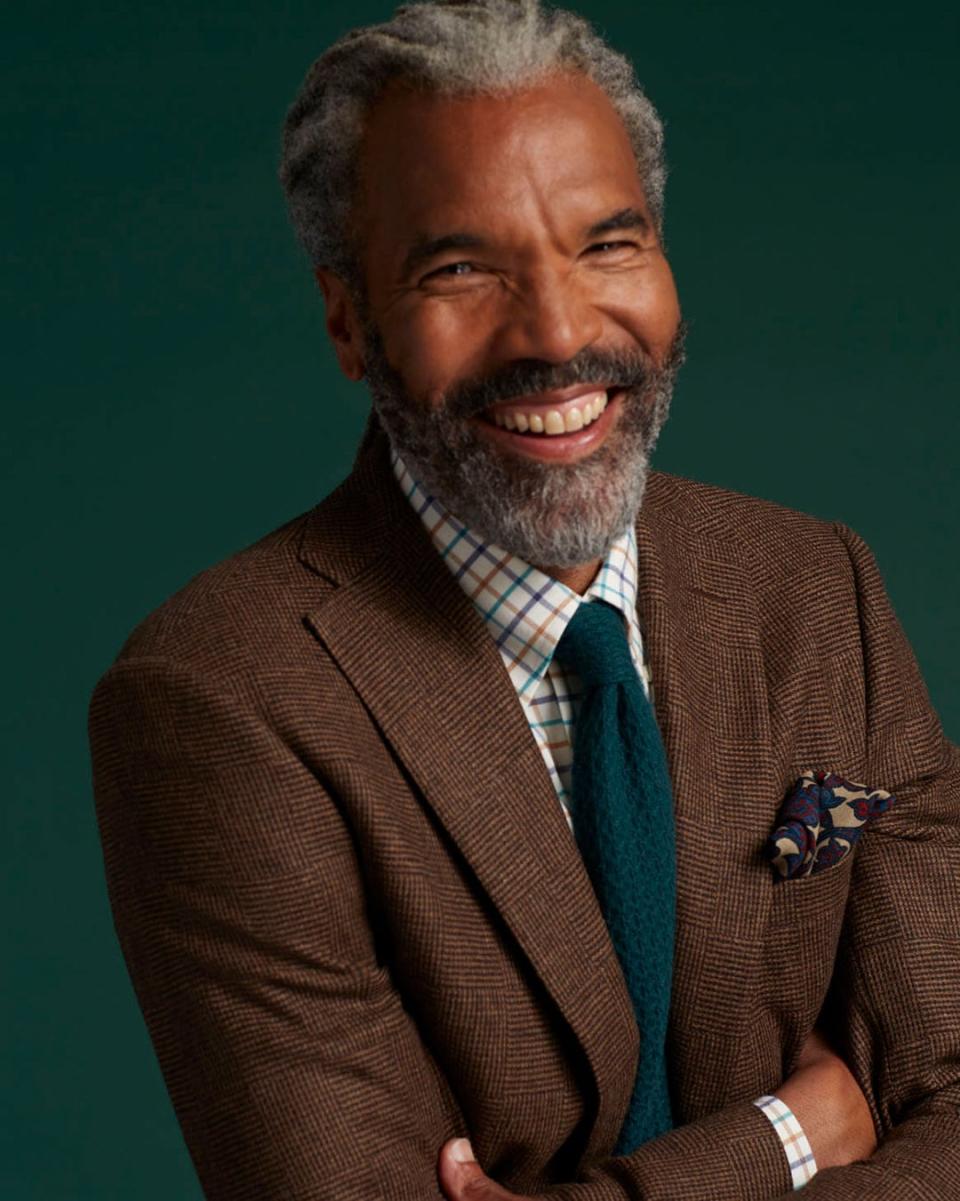Paul Stuart’s New CEO on His Game Plan for Growth

Trevor Shimpfky is the nervous sort.
Despite a résumé that includes Ermenegildo Zegna, Hugo Boss and Robert Talbott, he admits that meeting Paulette Garafalo, president and chief executive officer of Paul Stuart, for the first time was a bit nerve wracking.
More from WWD
“I knew of Paulette through my career but had never met her,” he said.
Despite his jitters, they hit it off and she hired him four years ago as the vice president of omnichannel for the New York-based specialty store.
Last July, Shimpfky was Garafalo’s handpicked successor to take over her position when she transitioned to executive chairman.
In his first interview since being named CEO, Shimpfky was almost giddy with excitement about the opportunities for the retailer that was founded in 1938 by Ralph Ostrove and operates stores on Madison Avenue and in Southampton in New York as well as in Chicago and Washington, D.C. It also has an outlet across the street from its New York flagship to clear excess inventory, as well as a newly opened company-owned flagship in Aoyama, Tokyo, and some 80 shops-in-shop and close to 500 corners in Japan.
Since 2012, Paul Stuart has been owned by Mitsui, the company’s longtime Japanese licensee, which purchased it from the founding family. Shimpfky said he’s received the blessing of the owners for his plans, which include adding three stores in the U.S. over the next five years, expanding wholesale, further enhancing the omnichannel presence and better positioning the company to attract a younger client.
He’s also proving he’s not afraid to make big decisions. Case in point: the impending exit of womenswear.
“We’re going to be pausing on women’s,” he said. “This fall is our last collection. Once we sell through, which we expect will happen by the end of December or January, we’ll move whatever we have to our outlet. Then we’ll just focus our energies and our monies on the other categories.”
But that doesn’t necessarily mean forever, he stressed. “There’s always a door to open again if we decide to do that.”

Women’s never represented a large percentage of Paul Stuart’s volume and since the flagship was significantly downsized last year, it made less sense to keep the category going.
“When I first got here, the whole first floor of the town house was the women’s store and it was beautiful,” Shimpfky said. “But we just can’t do it anymore, there’s not enough space. So that was a tough decision we had to make.”
Since its founding, the store spanned 30,000 square feet on two floors and a mezzanine on 45th Street and Madison Avenue. During the pandemic, the decision was made to return the second floor to the landlord — Paul Stuart never owned the building — and shrink the selling space to 15,000 square feet. The expansive tailored clothing department on the second floor was relocated to the back of the main floor along with furnishings and formalwear, putting sportswear front and center, along with the more modern Phineas Cole collection. The hair salon that had been installed during a 2017 renovation of the store was turned into the tailor shop and the company took the smaller space across Madison Avenue for its clearance store, PS 45. The basement, which had previously been used for storage, was turned into a state-of-the-art photo studio and offices.
“We like this layout,” he said. “We think it’s more modern.”
The customers apparently agree. Although the company was braced for a negative reaction from its longtime shoppers to the smaller footprint, Shimpfky said it has actually improved business since salespeople can now help a customer navigate all the departments rather than passing them on to someone else upstairs.
“Our average transaction value is up 50 percent to pre-pandemic levels,” he revealed.
Although the physical space may have changed, Paul Stuart’s focus on product has remained paramount. The collection is designed by Ralph Auriemma, the store’s longtime creative director, who has taken a higher profile in recent years.

“Partnering with Ralph is, for me, the most exciting part of the job,” Shimpfky said. “He’s the most creative designer I’ve seen in my career and we’re really unleashing him. What we have to do is create demand. Everything in the store has to be something that’s original and unique and can’t be found anywhere else. When I first got into this business and came into this store, everything was proprietary to this place. We need to get back to that golden age of Paul Stuart and create a clear brand identity.”
That brand identity needs to span both the physical stores and the online, he believes. Four years ago, the two categories were “very split,” he said. “The stores were doing their thing and we weren’t acting in an omni fashion. Our website was old and crotchety. So we partnered with Salesforce and really started cranking up our digital enterprise.” The result, he said, is “like comparing a jalopy to a Mercedes 560SL.”
Helping him with that transformation is Aslihan Danisman, who worked with Shimpfky at Zegna and serves as vice president of digital and CRM.
The timing turned out to be “very fortuitous,” he said, since the updated website launched five months before the pandemic hit and the stores were forced to close. But thanks to the new and improved website, “we kept shipping e-commerce and it kept the lights on and let our ownership know we were all very passionate and driven here.”
Although much of Shimpfky’s background is in product, he said he’s always been more interested in the business side of the industry and believes he can put his mark on Paul Stuart by helping the company be more modern.

“Thank goodness for Aslihan, and what she’s done as far as creating a customer journey that builds demand for people to keep coming back,” he said. “That’s really the emphasis right now. The stores are doing well and the e-commerce continues to be good. But I think we’re facing what everybody else is facing, which is the expectation as we came out of COVID-19 that e-commerce would continue full throttle. But as Mark Zuckerberg said a couple of weeks ago, that’s just not happening.”
E-commerce accounts for around 20 percent of the company’s overall sales and it’s the physical stores that are leading the way — and they’re performing well. In addition to the New York flagship, which has seen its sales and traffic improve in recent months, the unit in Washington, D.C., has bounced back after a rough couple of years and the store in Southampton, which started as a pop-up and is now permanent and year-round, has shown some “nice activity during the fall and holiday time,” he said.
The remaining store on Oak Street in Chicago is also doing well. At one time, Shimpfky said, there was a second unit on Lasalle Street, but it was destroyed during the race riots in May 2020 and the decision was made to step back and focus the energies on the remaining store. “That just made the most sense,” he said.
Going forward, he declined to identify the cities Paul Stuart is exploring for additional stores but said they would be concentrated in the Northeast and Southeast.
Although e-commerce has slowed since its peak during the pandemic, Shimpfky said the company remains bullish overall. “We have the full confidence of our ownership and we’re all aligned — from the e-commerce team to the merchants. We’re driving a full-price business again, and really trying to keep away from the discounts and the specials and the flash sales.”
He said the stores held tight and didn’t break sale until after Father’s Day this year and will continue to sell at full price until Dec. 26.
In addition to its own direct-to-consumer efforts, Paul Stuart has begun wholesaling in recent years. It started with footwear, which was sold at Neiman Marcus, Saks Fifth Avenue and Bergdorf Goodman as well as Nordstrom and Mr Porter. Last year, the wholesale offering expanded into tuxedos and formal accessories, which are being sold at Saks.
“Paul Stuart has an incredible reputation for tailored clothing,” he said, adding that the category still accounts for around 60 percent of overall sales. “How many times have we heard that tailored clothing is dead? We heard it in 2008, we heard it after 9/11, we heard it when the Silicon Valley e-comm boom happened when everyone was wearing T-shirts. But how many times has that not been the case?”

The death knell was sounded again during the pandemic when everyone was working from home. But now that men have returned to the office, the tailored clothing business is booming.
“We held our position and the business has been going bananas since we reopened the doors. A few months ago, 80 percent of the store business was in tailored clothing. And it’s not just New York, it’s D.C. and Chicago too and we’re even getting requests in Southampton for tailored clothing.”
Along with suits, high-end sportwear is also strong, he said, and the goal is to have the category achieve parity with tailored clothing as the company begins offering more athleisure and golfwear going forward.
Among the top performers right now are the brand’s polo shirts, featuring its man-on-a-fence logo — a business five times as big as it was three years ago — along with cashmere sweaters and casual bottoms.
He said Auriemma recently returned from a two-week trip to Italy “electrified” with the creative opportunities for future product designs and the company set out to whet the appetites of its customers by touting his visit on social media and email correspondence.
By the time Auriemma’s new collections hit, the New York flagship will have completed some physical changes. “Our plans are to create a shoe salon in the front of the store,” Shimpfky said. “We’ll do that right after the holidays.”
The Custom Lab, the company’s opening price point made-to-measure collection, is housed on the main floor, but will move to the mezzanine in the new year.
Other changes will include a subtle repositioning of the Phineas Cole label. The collection, which Shimpfky said has been growing thanks in part to strong social media marketing efforts, will be renamed Phineas Cole for Paul Stuart to better connect the two names.
The price points of the two labels are about the same, he said, but Phineas offers a younger silhouette with a more narrow leg in the tailored clothing and some “edgy” pieces such as a woven silk dinner jacket with an Art Deco-inspired print of city skyscrapers and a silk rope frog closure for $3,295, and silk shirts that feature contemporary bird and butterfly prints that retail for $1,195. “It doesn’t look like anything else out there,” he said.
As he strives to create the framework for “Paul Stuart 2.0,” Shimpfky said the company will continue to enhance its marketing efforts to focus on what makes it unique. That includes the company’s distinct fit for its signature tailored clothing as well as its more affordable price point. Suits are available for $2,395, less than comparably made models from other brands and retailers.
The store is also known for its propensity for color. In fact, the retailer uses a campaign, “Life Is Colorful,” to get that message across. There is also a weekly email called Ralph Raves that highlights the “newest and coolest thing to come in that week,” he said. Those pieces are also promoted online.
“We’re engaging in a different way than we used to,” he said. “We want to lead with digital and that doesn’t just mean our website. We’ve got to get away from manual processes and engage the next generation,” he said.
Toward that end, the company recently added Victor Netland, a 22-year-old recent college graduate, to its team to promote the brand on TikTok. As Shimpfky wrote to customers, Netland will be “educating on special items that make Paul Stuart so very unique.”
The efforts appear to be paying off. From September 2021 until today, 56 percent of customers are new to the brand.
In addition, there is talk beginning to bring Paul Stuart to other international countries, but “we’re just at the starting point,” he said.

